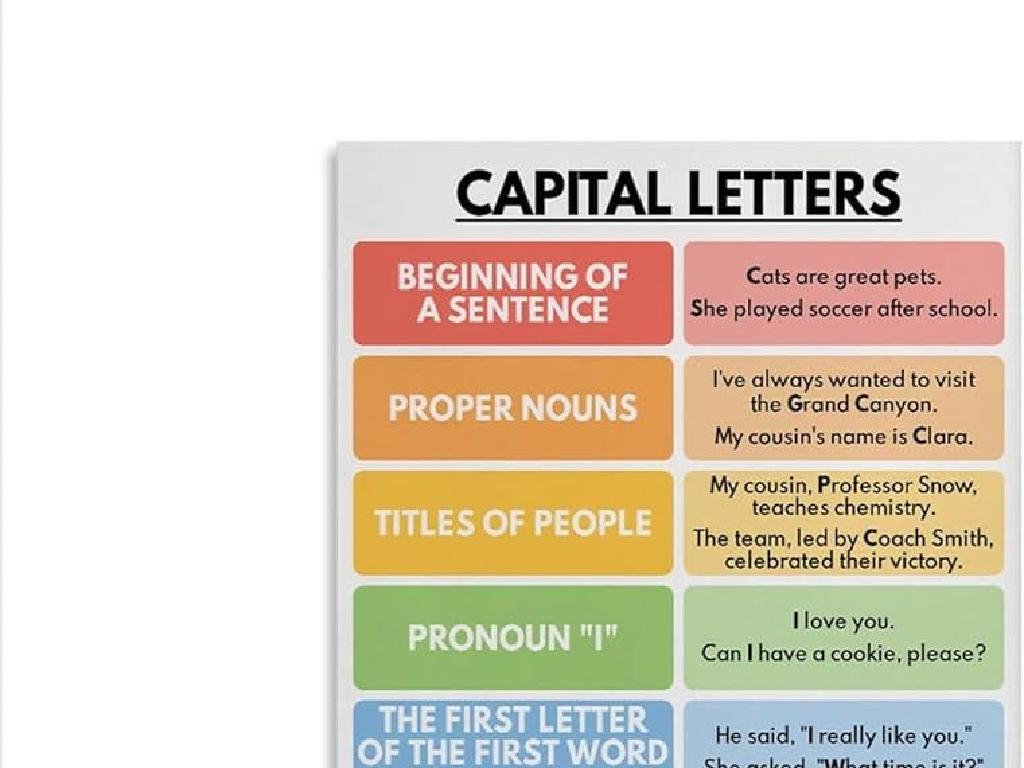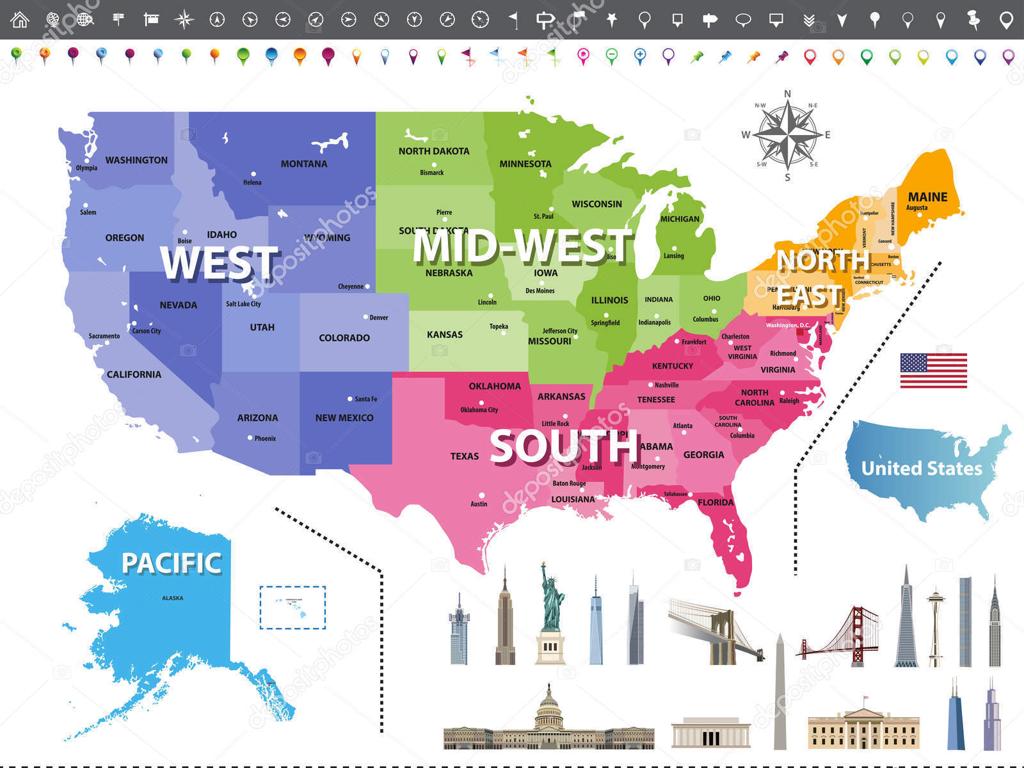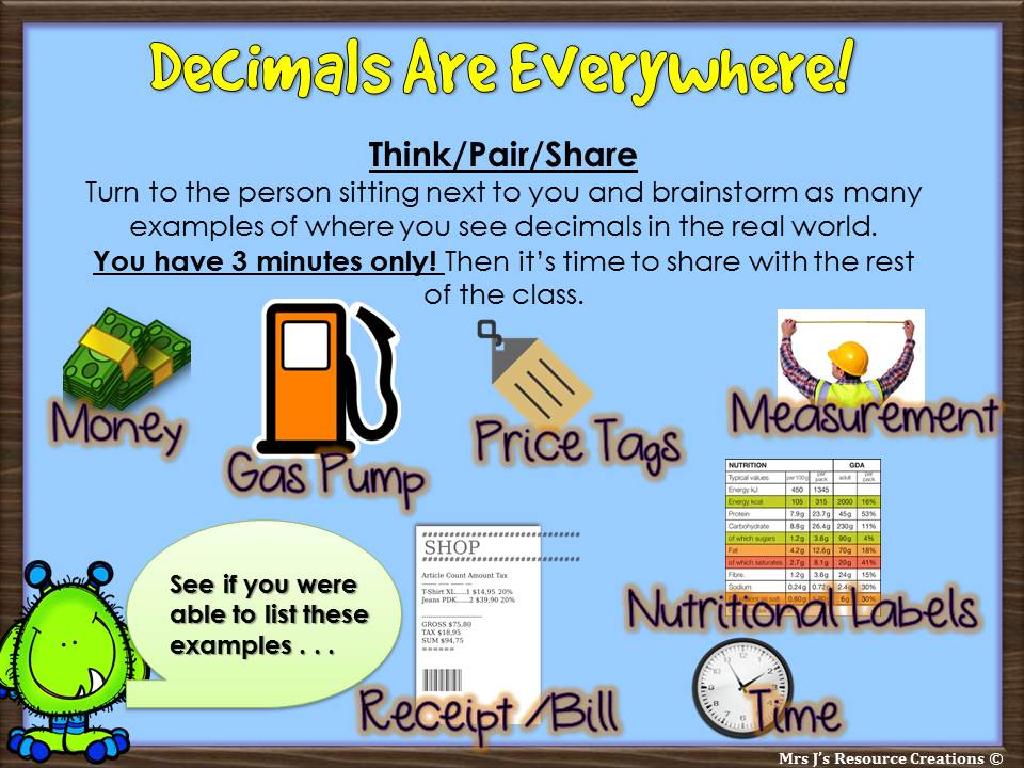Complete The Sentence With The Correct Short Vowel Word
Subject: Language arts
Grade: First grade
Topic: Short Vowels
Please LOG IN to download the presentation. Access is available to registered users only.
View More Content
Welcome to Short Vowels!
– Learn about short vowel sounds
– Vowels: A, E, I, O, U
– Short vowels in words
– Short vowels sound like: ‘a’ in cat, ‘e’ in bed, ‘i’ in sit, ‘o’ in hot, ‘u’ in sun
– Practice with examples
– We’ll complete sentences using the right short vowel word
|
This slide introduces first graders to the concept of short vowel sounds. Start by explaining that vowels are special letters in our alphabet and that they can make different sounds. The focus of this lesson is on the short sounds that vowels make in certain words. Provide examples for each vowel and ensure that students repeat the sounds after you. Engage the class by asking them to come up with more words that contain short vowel sounds. For practice, prepare a few sentences with missing words and have the students fill in the blanks with the correct short vowel word. This activity will help reinforce their understanding of short vowels in a fun and interactive way.
Meet the Short Vowels
– Each vowel has a short sound
– Learn the sounds of A, E, I, O, U
– ‘A’ as in ‘apple’, ‘E’ as in ‘elephant’, ‘I’ as in ‘igloo’, ‘O’ as in ‘octopus’, ‘U’ as in ‘umbrella’
– See how vowels sound in words
– Words like ‘cat’, ‘bed’, ‘fish’, ‘pot’, ‘bug’ show short vowel sounds
– Practice with vowel examples
– We’ll practice with words like ‘hat’, ‘net’, ‘pig’, ‘top’, ‘cup’
|
This slide introduces first graders to the concept of short vowel sounds. Start by explaining that vowels are special letters in our alphabet that can make different sounds. Focus on the short sounds that each vowel makes, and provide examples for each vowel. Use common words that they are likely to know to help them connect the sound to the letter. After explaining, engage the students with practice examples where they can try to identify the short vowel sounds in simple words. This will help reinforce their understanding and ability to recognize these sounds in their reading.
Exploring the Short ‘A’ Sound
– ‘A’ as in ‘apple’
– The short ‘A’ sound is like the ‘a’ in ‘apple’ and ‘cat’.
– Practice saying the ‘A’ sound
– Repeat after me: ‘A’ – ‘apple’, ‘A’ – ‘ant’, ‘A’ – ‘ax’.
– Find words with ‘A’
– Look for short ‘A’ words in your favorite book.
– Listen for ‘A’ in sentences
– I will say a sentence, and you tell me the ‘A’ word.
|
This slide introduces the short ‘A’ sound to first graders, helping them recognize and pronounce it correctly. Start by explaining the sound and giving examples like ‘apple’ and ‘cat’. Engage the class by having them repeat the sound after you. Then, encourage them to find and list words containing the short ‘A’ sound, possibly from a book they enjoy. Finally, practice listening skills by saying sentences that include short ‘A’ words and asking students to identify them. This interactive approach helps solidify their understanding of vowel sounds in a fun and engaging way.
The Sound of ‘E’: Short Vowel Exploration
– ‘E’ as in ‘bed’ and ‘net’
– Practice the short ‘E’ sound
– Let’s say ‘E’ together and listen to its sound!
– Find words with the short ‘E’
– Think of words in our books or at home with ‘E’
– Share our short ‘E’ words
– We’ll tell the class our words with ‘E’
|
This slide is aimed at helping first graders recognize and pronounce the short ‘E’ sound, which is similar to the ‘E’ in ‘bed’ and ‘net’. Start by pronouncing the sound clearly and ask the students to repeat after you. Then, engage the class in a brainstorming activity to come up with words that contain the short ‘E’ sound. Encourage them to think of words from stories, their surroundings, or daily life. After they have come up with words, have a few students share their words with the class. This will help reinforce the sound and improve their ability to recognize it in different words. Make sure to provide positive feedback and support as they practice this new sound.
The Sound of ‘I’: Short Vowel Practice
– ‘I’ as in ‘fish’ and ‘pig’
– The short ‘I’ sounds like the ‘i’ in ‘fish’ or ‘pig’.
– Repeat the ‘i’ sound together
– We’ll say the ‘i’ sound as a class to practice.
– List words with the ‘i’ sound
– Think of ‘sit’, ‘hit’, ‘lip’, and ‘kit’.
– Practice using ‘i’ in sentences
– We’ll write sentences with our ‘i’ words.
|
This slide is aimed at helping first graders recognize and practice the short ‘I’ sound. Start by demonstrating the sound yourself and then ask the class to repeat after you. This auditory exercise will help them remember the sound. Next, engage the class in a brainstorming session to list words that contain the short ‘I’ sound, writing them on the board as they participate. Finally, encourage the students to use these words in sentences, which will help solidify their understanding of the sound and its usage in language. For the activity, consider breaking the class into small groups and have each group come up with a short story using their list of words, or have individual students come to the board to write sentences with their chosen words.
Exploring the Short ‘O’ Sound
– ‘O’ as in ‘dog’ and ‘frog’
– Practice saying the short ‘O’
– Repeat after me: ‘o’ in ‘dog’, ‘o’ in ‘frog’
– Find words with the short ‘O’
– Think of ‘o’ in ‘log’, ‘pot’, ‘top’
– Share your words with the class
|
This slide is aimed at helping first graders recognize and pronounce the short ‘O’ sound, as heard in words like ‘dog’ and ‘frog’. Start by saying the words aloud and have the students repeat after you to practice the sound. Then, engage the class by asking them to brainstorm other words that contain the short ‘O’ sound. Encourage them to look around the classroom for inspiration or think about their favorite toys and activities. As they come up with words, write them on the board and say them together. This interactive approach helps students associate the sound with various words and reinforces their phonemic awareness.
The Sound of ‘U’: Short Vowel Practice
– ‘U’ as in ‘sun’
– The short ‘U’ sounds like the ‘u’ in ‘sun’ and ‘duck’.
– Practice the ‘U’ sound
– We’ll say words together to learn this sound.
– Find words with ‘U’
– Can you think of a word with the short ‘U’ sound?
– Listen and repeat
– I’ll say a word, and you echo it back!
|
This slide is aimed at helping first graders recognize and practice the short ‘U’ sound. Start by explaining the sound, using familiar words like ‘sun’ and ‘duck’ as examples. Engage the class in a group practice, saying words aloud and having the students repeat them. Encourage the children to come up with their own examples of words that contain the short ‘U’ sound. Finish with a listening and repeating activity to reinforce the sound. Make sure to speak clearly and give positive feedback to the students as they practice.
Complete the Sentence with Short Vowels!
– Use knowledge to complete sentences
– Choose the right short vowel word
– Pick a word with a, e, i, o, or u sound
– Recall our vowel sound practice
– A as in apple, E as in bed, I as in fish, O as in dog, U as in sun
– Fill in the blanks together
|
This slide is designed to reinforce the students’ understanding of short vowel sounds within the context of sentence completion. Encourage the children to apply their knowledge of short vowel sounds to select the appropriate word to complete each sentence. Remind them of the vowel sounds they have practiced: ‘a’ as in ‘apple’, ‘e’ as in ‘bed’, ‘i’ as in ‘fish’, ‘o’ as in ‘dog’, and ‘u’ as in ‘sun’. During the activity, work through examples together and provide immediate feedback. This interactive approach helps solidify their learning and allows them to demonstrate their grasp of short vowels in a fun and engaging way.
Filling in the Blanks with Short Vowel Sounds
– Complete the sentence with a vowel
– ‘The cat sat on the ____.’
– What word fits here with a short vowel sound?
– ‘I can ____ the bell ring.’
– Find a word with a short vowel that makes sense
– Practice together, then individually
|
This slide is aimed at helping first graders understand the concept of short vowel sounds and how they fit into sentences. Start by explaining that vowels are special letters (a, e, i, o, u) that can have short sounds. Use the example sentences to illustrate how to choose the correct short vowel word to complete a sentence. For ‘The cat sat on the ____,’ a word like ‘mat’ fits because it has the short vowel sound ‘a’ as in ‘cat.’ For ‘I can ____ the bell ring,’ a word like ‘hear’ fits with the short vowel sound ‘e.’ After going through a few examples together, encourage the students to try completing sentences with short vowel words on their own. This exercise will enhance their reading and phonics skills.
Class Activity: Vowel Hunt
– Let’s go on a vowel hunt!
– Find objects with short vowels
– Look for items like ‘hat’, ‘pen’, ‘jug’, ‘net’, ‘lip’
– Work in pairs for sentences
– Use the objects to fill in the blanks in sentences
– Share your sentences with the class
|
This activity is designed to help students recognize and understand short vowel sounds in a fun and interactive way. Have the students walk around the classroom to find objects that contain short vowel sounds. Encourage them to work in pairs to foster teamwork and communication. Once they have found their objects, guide them to use these items to complete sentences, reinforcing their understanding of short vowels in context. After completing the sentences, each pair will share their findings with the class, allowing for a collaborative learning experience. Possible sentences for the activity could be: ‘I wear a ___ on my head’, ‘I write with a ___’, ‘I drink water from a ___’, ‘I caught a fish with a ___’, ‘I kiss with my ___’. This will help students apply their phonics knowledge in a practical setting.





